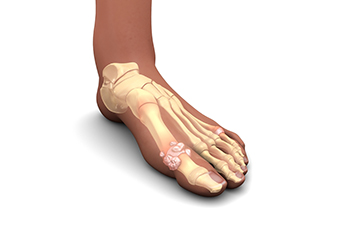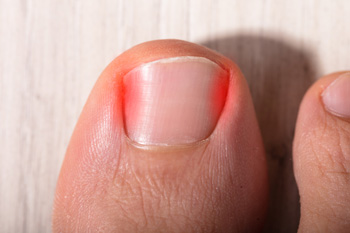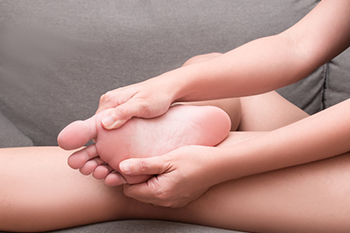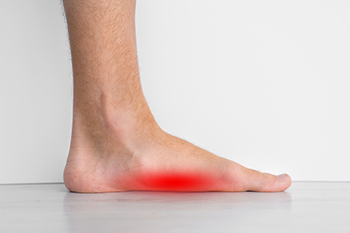Connect With Us
Blog
Items filtered by date: July 2022
Joint Pain in the Feet May Indicate One or More Type of Arthritis

Arthritis is an umbrella term for diseases that cause pain, inflammation, and in some cases a degradation of joints in the body. Gout is one such form of arthritis. It develops when your body cannot adequately flush out uric acid in the bloodstream, which is a byproduct of purines being broken down. This excess uric acid can crystalize, collect, and build up in joints. This accumulation of hardened uric acid crystals causes the joint to become inflamed, swollen, and painful. Gout can develop in any joint in the body, however it is most prevalent in the metatarsophalangeal (MTP) joint at the base of the big toe. If you have gout, there is a possibility that you may also have other forms of arthritis as well, as different forms of arthritis share certain risk factors and can create a hospitable environment for other arthritic diseases to take hold in the joints. If you have any pain, swelling, stiffness, or limited movement in any foot or ankle joint, see a podiatrist. By examining the feet and conducting various tests, your podiatrist will be able to properly diagnose your condition and treat it accordingly.
Gout is a foot condition that requires certain treatment and care. If you are seeking treatment, contact one of our podiatrists from Kokomo Foot & Ankle Center. Our doctors will treat your foot and ankle needs.
What Is Gout?
Gout is a type of arthritis caused by a buildup of uric acid in the bloodstream. It often develops in the foot, especially the big toe area, although it can manifest in other parts of the body as well. Gout can make walking and standing very painful and is especially common in diabetics and the obese.
People typically get gout because of a poor diet. Genetic predisposition is also a factor. The children of parents who have had gout frequently have a chance of developing it themselves.
Gout can easily be identified by redness and inflammation of the big toe and the surrounding areas of the foot. Other symptoms include extreme fatigue, joint pain, and running high fevers. Sometimes corticosteroid drugs can be prescribed to treat gout, but the best way to combat this disease is to get more exercise and eat a better diet.
If you have any questions, please feel free to contact our office located in Contact Us . We offer the newest diagnostic and treatment technologies for all your foot care needs.
Surgery for Ingrown Toenails

Ingrown toenails are unattractive and potentially uncomfortable foot ailments that primarily affect the big toenail. They occur when the side of the nail essentially grows into the skin of the toe. As a result, the affected area can swell, turn red, and become inflamed. There are many cases of ingrown toenails that, if caught early enough, can be treated and taken care of at home. Other cases can be addressed by a podiatrist with antibiotics or a splint and will not require surgery. However, if a case is severe enough and the ingrown toenail has become infected, then a surgery might be necessary to remedy the situation. There are a number of surgical procedures a doctor may perform. First, a doctor may perform a wedge resection (also known as a partial nail avulsion), in which a portion of the toenail causing the problem is removed. A doctor may also perform a toenail removal (or a complete nail plate avulsion) where the entire affected nail is removed. The intention behind this procedure is that the new nail will grow back correctly in 18 months. Of course, each patient’s potential to benefit from surgery for an ingrown toenail is highly individualized. As a standard rule of thumb, you can always consult with your podiatrist to determine the best treatment plan for your ingrown toenail.
Ingrown toenails can become painful if they are not treated properly. For more information about ingrown toenails, contact one of our podiatrists of Kokomo Foot & Ankle Center. Our doctors can provide the care you need to keep you pain-free and on your feet.
Ingrown Toenails
Ingrown toenails occur when a toenail grows sideways into the bed of the nail, causing pain, swelling, and possibly infection.
Causes
- Bacterial infections
- Improper nail cutting such as cutting it too short or not straight across
- Trauma to the toe, such as stubbing, which causes the nail to grow back irregularly
- Ill-fitting shoes that bunch the toes too close together
- Genetic predisposition
Prevention
Because ingrown toenails are not something found outside of shoe-wearing cultures, going barefoot as often as possible will decrease the likeliness of developing ingrown toenails. Wearing proper fitting shoes and using proper cutting techniques will also help decrease your risk of developing ingrown toenails.
Treatment
Ingrown toenails are a very treatable foot condition. In minor cases, soaking the affected area in salt or antibacterial soaps will not only help with the ingrown nail itself, but also help prevent any infections from occurring. In more severe cases, surgery is an option. In either case, speaking to your podiatrist about this condition will help you get a better understanding of specific treatment options that are right for you.
If you have any questions, please feel free to contact our office located in Contact Us . We offer the newest diagnostic and treatment technologies for all your foot care needs.
Sesamoiditis: A Common Running Injury

Sesamoiditis is an injury that affects many runners, particularly those who train on hard surfaces or rocks. Sesamoiditis occurs when the two tiny sesamoid bones that reside under the big toe get fractured and/or the tendons around the sesamoids become irritated and inflamed. Sesamoiditis may occur from the repeated impact a runner’s foot makes with the ground, or from other factors such as having tight toe flexors. Pain from sesamoiditis can be sharp and sudden, and is usually felt underneath the big toe or in the ball of the foot. If it feels like a burning pain, this may indicate nerve damage. A podiatrist can treat sesamoiditis with recommendations of rest, along with prescribing anti-inflammatory medications and reducing inflammation with other methods.
Sesamoiditis is an unpleasant foot condition characterized by pain in the balls of the feet. If you think you’re struggling with sesamoiditis, contact one of our podiatrists of Kokomo Foot & Ankle Center. Our doctors will treat your condition thoroughly and effectively.
Sesamoiditis
Sesamoiditis is a condition of the foot that affects the ball of the foot. It is more common in younger people than it is in older people. It can also occur with people who have begun a new exercise program, since their bodies are adjusting to the new physical regimen. Pain may also be caused by the inflammation of tendons surrounding the bones. It is important to seek treatment in its early stages because if you ignore the pain, this condition can lead to more serious problems such as severe irritation and bone fractures.
Causes of Sesamoiditis
- Sudden increase in activity
- Increase in physically strenuous movement without a proper warm up or build up
- Foot structure: those who have smaller, bonier feet or those with a high arch may be more susceptible
Treatment for sesamoiditis is non-invasive and simple. Doctors may recommend a strict rest period where the patient forgoes most physical activity. This will help give the patient time to heal their feet through limited activity. For serious cases, it is best to speak with your doctor to determine a treatment option that will help your specific needs.
If you have any questions please feel free to contact our office located in Contact Us . We offer the newest diagnostic and treatment technologies for all your foot and ankle needs.
Flat Feet and the Military

There are millions of people worldwide that are affected by flat feet. They can be a disqualifying condition for people who are interested in joining the military if the symptoms of flat feet are noticeable and present. Some symptoms can include pain in the arch or heel, and the ankles being swollen. Most babies are born with flat feet and the arch typically develops during the teenage years. People who never develop an arch may have no symptoms, or in the opposite case, symptoms may be obvious. These can consist of tiring easily, limited range of foot movement, and there may be a pain in the feet after walking or running. An effective method to determine if you have flat feet involves standing on your tiptoes and looking for an arch in the foot. Doing so may indicate a low arch or the arch may be nonexistent. Some patients perform foot exercises that help flat feet from being achy. If you would like to learn more about exercises and treatments for flat feet, please consult with a podiatrist.
Flatfoot is a condition many people suffer from. If you have flat feet, contact one of our podiatrists from Kokomo Foot & Ankle Center. Our doctors will treat your foot and ankle needs.
What Are Flat Feet?
Flatfoot is a condition in which the arch of the foot is depressed and the sole of the foot is almost completely in contact with the ground. About 20-30% of the population generally has flat feet because their arches never formed during growth.
Conditions & Problems:
Having flat feet makes it difficult to run or walk because of the stress placed on the ankles.
Alignment – The general alignment of your legs can be disrupted, because the ankles move inward which can cause major discomfort.
Knees – If you have complications with your knees, flat feet can be a contributor to arthritis in that area.
Symptoms
- Pain around the heel or arch area
- Trouble standing on the tip toe
- Swelling around the inside of the ankle
- Flat look to one or both feet
- Having your shoes feel uneven when worn
Treatment
If you are experiencing pain and stress on the foot you may weaken the posterior tibial tendon, which runs around the inside of the ankle.
If you have any questions please feel free to contact our office located in Contact Us . We offer the newest diagnostic and treatment technologies for all your foot and ankle needs.

